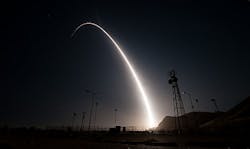Nuclear forces, command and control, sensors, information security top DOD budget research priorities
WASHINGTON – The U.S. Department of Defense (DOD) could see its largest research and development DOD budget in more than a decade next year, as military planners are seeking sizable research increases in nuclear forces, command and control, sensors, information security, and many other areas.
DOD is asking for $82.33 billion in fiscal 2018 for research, development, test, and evaluation (RDT&E), which is up 15.2 percent from 2017 levels of $72.32 billion.
The Pentagon's research budget handles weapons and enabling technologies from the basic laboratory level through to advanced systems development. This budget is intended to create cutting-edge military technologies, capabilities, and defense systems.
The RDT&E budget also is expected to influence future-year procurement and operations and maintenance budgets, as research typically is at the beginning of the long military systems development, procurement, and maintenance pipeline.
All the U.S. military services except the U.S. Navy have increases their research budgets next year. The Pentagon submitted its 2018 budget request to Congress late last month. Federal fiscal year 2018 begins next October 1.
The U.S. Army's proposed research budget for next year is $9.54 billion, up 18.5 percent from 2017's $8.05 billion; the Navy is asking for $17.8 billion, down 4 percent from 2017's $18.53 billion; the Air Force is asking for $35.05 billion, up 34 percent from 2017's $26.08 billion; and defense agencies are asking for $20.72 billion, up 6.5 percent from 2017's $19.46 billion.
Among the big-spending defense research agencies, the Missile Defense Agency is asking for $6.2 billion in 2018, up 3.9 percent from 2017's $5.97 billion; the Office of the Secretary of Defense (OSD) is asking for $4.07 billion, up 7.8 percent from 2017's $3.77 billion; the Defense Advanced Research Projects Agency (DARPA) is asking for $3.17 billion, up 6.6 percent from 2017's $2.97 billion; the Chemical and Biological Defense Program is asking for $1.1 billion, up 23.8 percent from 2017's $8.85 million; Special Operations Command (SOCOM) is asking for $644.2 million, up 21.6 percent from 2017's $529.9 million; and the Defense Information Systems Agency (DISA) is asking for $256.5 million, up 3.1 percent from 2017's $248.7 million.
Among 2018's big research plus-ups for the Army are $160.7 million for aviation advanced technology, up 70.5 million from 2017's $94.3 million; $52.2 million for advanced tactical computer science and sensor technology, up 18 percent from 2017's $44.2 million; $27.7 million for the tactical Electronic Surveillance System, up 76.3 percent from 2017's $15.7 million; $76.2 million for the Lower Tier Air Missile Defense Sensor (LTAMDS), up 118.4 percent from 2017's $35.1 million; and $56.5 million for cyberspace operations forces and force support, up 39.5 percent from 2017's $40.5 million.
The Army also is asking for $336.4 million for the Army Integrated Air and Missile Defense (AIAMD) system, up 23 percent from 2017's $272.8 million; $199.8 million for the Armored Multi-Purpose Vehicle (AMPV), up 8.4 percent from 2017's $184.2 million; $175.1 million for the Indirect Fire Protection Capability Increment 2 Block 1, up 108.4 percent from 2017's $84 million; $71.7 million for electronic warfare development, up 92.4 percent from 2017's $37.2 million; and $33 million for radar development, up 106.3 percent from 2017's $16 million.
The Army also wants $102.8 million for the Guided Multiple-Launch Rocket System (GMLRS), up 170.2 percent from 2017's $38 million; $132.4 million for the Information Systems Security Program, up 246 percent from 2017's $38.3 million; and $16.9 million for tactical unmanned aerial vehicles, up 106 percent from 2017's $8.2 million.
The Navy next year wants to spend $143.5 million on frigate development, up 69 percent from 2017's $84.9 million. Navy officials are looking into adapting a version of the littoral combat ship for blue-water frigate service. The Navy also wants $776.2 million next year for the Ohio Replacement program to develop a new fleet ballistic missile submarine, up 10.8 percent from 2017's $700.8 million.
Other Navy research plans on tap for 2018 include $632.9 million for the Next-Generation Jammer, up 9.5 percent from 2017's $577.8 million; $106.4 million for the Joint Precision Approach and Landing System demonstration and validation, up 2.2 percent from 2017's $104.1 million; $229.4 million to modernize the RQ-4 Global Hawk long-range unmanned aerial vehicle, up 26.6 percent from 2017's $181.3 million; and $107.3 million for directed-energy and electric weapons development, up 228.2 percent from 2017's $32.7 million.
Topping the U.S. Air Force's research priorities for 2018 is $2 billion for the Long-Range Strike bomber program, up 76.5 percent from 2017's $1.1 billion; $231.7 million for cyber operations technology development, up 42.4 percent from 2017's $162.7 million; $215.7 million for the Ground-Based Strategic Deterrent project to develop a new intercontinental ballistic missile to replace the Minuteman III, up 89.4 percent from 2017's $113.9 million; $417.2 million for the Joint STARS recapitalization program to rebuild the Joint Surveillance Target Attack Radar System aircraft to like-new condition, up 255.9 percent from 2017's $128 million; and $451.3 million for the Long-Range Standoff Weapon, up 372 percent from 2017's $95.6 million.
In other research projects, the Air Force plans to upgrade several aircraft and missile systems. For these upgrades the Air Force wants $610.9 million for F-22 fighter squadrons, up 57.6 percent from 2017's $387.6 million; $181.5 million for F-35 joint strike fighter squadrons, up 118.6 percent from 2017's $153 million; $210.8 million for Minuteman intercontinental ballistic missile squadrons, up 15.2 percent from 2017's $183 million; $201.4 million for the MQ-9 Reaper attack drone, up 33 percent from 2017's $151.4 million; $151.7 million for the Airborne Warning and Control System (AWACS) aircraft, up 75.1 percent from 2017's $86.6 million; and $108.6 million for the UH-1N helicopter replacement program, up 669.4 percent from 2017's $14.1 million.
DOD research agencies next year want to spend $428.9 for network-centric warfare technology advanced development, up 2.4 percent from 2017's $428.9 million; $465.5 million for improved homeland defense interceptors, up 69.8 percent from 2017's $274.1 million; $219.8 million for microelectronics technology development and support, up 124.7 percent from 2017's $97.8 million; $79.1 million for advanced electronics technologies, up 59 percent from 2017's $49.8 million; $75.3 million for a new item, hypersonic defense; and $130.7 million for the Sea-Based X-Band Radar (SBX), up 41 percent from 2017's $93.3 million.
U.S. Special Operations Command, meanwhile, wants to spend $259.9 million next year on special forces aviation systems, up 58.9 percent from 2017's $163.5 million.
Learn more: search the Aerospace & Defense Buyer's Guide for companies, new products, press releases, and videos



